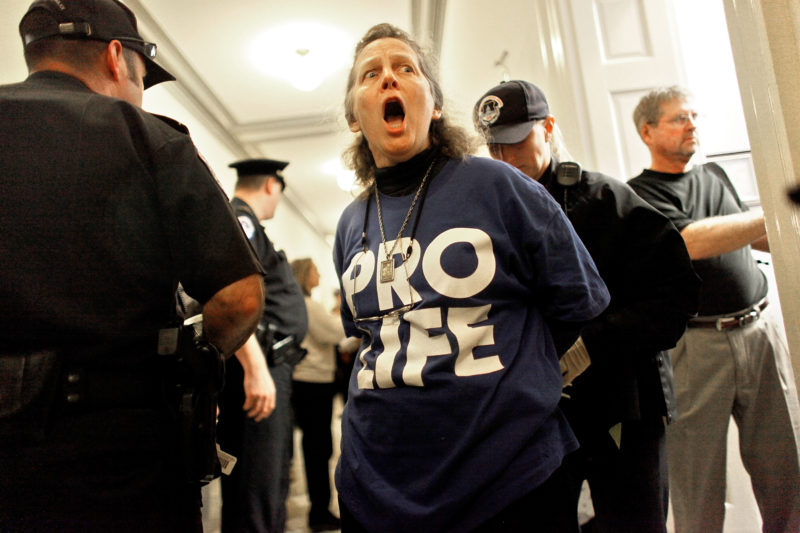‘Nothing Has Changed’: Colorado Planned Parenthood Official on Anti-Choice Rhetoric Three Years After Shooting
“There’s just this palpable level of dissension and fear. It almost makes me feel like this is going to happen again."

It’s been three years since a shooter, who would later repeat talking points from an anti-choice propaganda campaign, walked into a Planned Parenthood clinic in Colorado and killed three people. Dr. Savita Ginde, the clinic’s medical director at the time of the shooting, warns the anti-choice movement’s violent rhetoric still poses a grave threat to providers and patients who seek reproductive health care.
On November 27, 2015, Robert Lewis Dear Jr. entered the Colorado Springs clinic and began shooting an assault-style rifle. By the time he surrendered after a standoff that lasted several hours, three were killed and nine were wounded.
The attack came just a few months after the anti-choice front group known as the Center for Medical Progress (CMP) released a string of highly-edited and misleading videos purporting to show abortion providers engaging in nefarious activity. One of the videos included footage showing Dr. Ginde discussing Planned Parenthood’s program that provides fetal tissue, donated by people who have an abortion or miscarriage, for use in medical research. The anti-choice movement held up the videos as evidence that Planned Parenthood was an unethical organization involved in the illegal sale of fetal organs, despite a lack of proof of any lawbreaking.
The anti-choice movement erupted, and their outrage was directed in large part at Dr. Ginde. She was forced to flee her home after protesters descended upon her neighborhood and handed out flyers that said things like “Savita Ginde murders children at Planned Parenthood with your consent.”
Dear used the phrase “no more baby parts” to law enforcement to explain his actions at the time of his arrest. Dear has repeatedly been deemed mentally incompetent to stand trial.
The anti-choice movement has been quick to distance itself from overtly violent acts by those opposed to abortion rights, but Ginde asserts the shooting serves as an example of how the movement’s intentionally inflammatory rhetoric can lead to a deadly result.
“The man who did the shooting was delusional, but he was triggered, and he was triggered by the videos, and he was triggered by the aftermath of the videos that played itself out through social media platforms,” Ginde told Rewire.News. “For me, the thing that should come out of it is people taking ownership that their language and their taking to social media to express their views has a toll and can create a snowball effect.”
“You have to kind of watch out what you wish for,” she said.
Dear isn’t the only one who appears to have been influenced by the heavily edited CMP videos, which prompted Republican-led investigations into Planned Parenthood that turned up nothing. A report from the National Abortion Federation (NAF) revealed that 2015 saw a spike in incidents of anti-choice hate speech, internet harassment, death threats, attempted murder, and murder, incidents that coincided with the Planned Parenthood smear campaign—a campaign coordinated by CMP and GOP lawmakers.
The incidents documented in the NAF report include 94 threats of direct harm against abortion providers in 2015, compared to only one such threat the year prior.
Ginde, for one, is worried that “nothing has changed” since 2015 to de-escalate the violent anti-choice rhetoric that led to the shooting.
“What scares me the most when I take my own pulse of what’s going on is that there’s just this palpable level of dissension and fear. It almost makes me feel like this is going to happen again,” Ginde said. “Right or left, wherever you stand, I would never want what we went through to happen to somebody else. We’ve got to be better than that.”
Ginde hopes to open up discussion about how to combat anti-choice violence with her upcoming book, The Real Cost of Fake News: The Hidden Truth Behind the Planned Parenthood Video Scandal, which comes out this month.
“We have to make sure that people are looking at the facts, and that we’re making decisions based on scientific facts and research and not on rhetoric,” Ginde said. “It’s the dramatic and sensationalized verbiage that gets us into a no-win situation, and if no one wins, then what’s the point?”
One way to move forward, she says, is to work toward a shared goal of reducing the abortion rate by making birth control more accessible.
In Colorado, for example, a state-run program that provided IUDs at little or no cost to teens was highly successful at reducing teen pregnancy—and cut the state’s teen abortion rate nearly in half. Still, some Republican state lawmakers opposed the program and attempted to slash funding.
“We have to find a solution, and there are solutions, and so the question is, why aren’t we embracing those solutions?” Ginde said. “If someone is against birth control, they can have that belief and carry that through, but I don’t understand why they would want someone who has a different belief to have to abide by theirs.”
